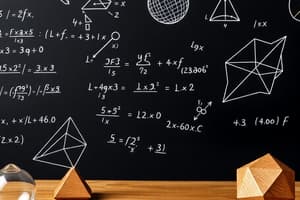Podcast
Questions and Answers
Which of the following operations is NOT included in arithmetic?
Which of the following operations is NOT included in arithmetic?
- Addition
- Division
- Derivatives (correct)
- Multiplication
What is the Pythagorean theorem primarily used for?
What is the Pythagorean theorem primarily used for?
- Determining volume of three-dimensional shapes
- Finding lengths of sides in a right triangle (correct)
- Calculating area of a triangle
- Identifying angles in polygons
Which measure of central tendency represents the value that occurs most frequently in a data set?
Which measure of central tendency represents the value that occurs most frequently in a data set?
- Mode (correct)
- Median
- Mean
- Range
Which type of number includes whole numbers and their negatives?
Which type of number includes whole numbers and their negatives?
In the context of functions, what do the terms 'domain' and 'range' refer to?
In the context of functions, what do the terms 'domain' and 'range' refer to?
Flashcards are hidden until you start studying
Study Notes
Types of Math
-
Arithmetic
- Basic operations: addition, subtraction, multiplication, division.
- Number sense: whole numbers, integers, fractions, decimals.
-
Algebra
- Variables and expressions.
- Equations and inequalities.
- Functions and their graphs.
-
Geometry
- Properties of shapes (triangles, circles, polygons).
- Theorems (Pythagorean theorem, congruence).
- Area, perimeter, volume calculations.
-
Trigonometry
- Sine, cosine, tangent functions.
- Right triangle relationships.
- Unit circle and radian measure.
-
Calculus
- Limits and continuity.
- Derivatives: definition and application.
- Integrals: definite and indefinite.
-
Statistics
- Data collection and analysis.
- Measures of central tendency: mean, median, mode.
- Probability fundamentals.
-
Discrete Mathematics
- Combinatorics: permutations and combinations.
- Graph theory: vertices, edges, paths.
- Logic: propositions, truth tables.
Key Concepts
-
Order of Operations: Parentheses, Exponents, Multiplication and Division (left to right), Addition and Subtraction (left to right).
-
Number Systems:
- Natural numbers, integers, rational numbers, irrational numbers, real numbers.
-
Functions:
- Domain and range.
- Types: linear, quadratic, polynomial, exponential, logarithmic.
-
Equations:
- Linear equations: y = mx + b.
- Quadratic equations: ax² + bx + c = 0.
-
Probability:
- Basic concepts: events, sample space, complementary events.
- Basic rules: addition rule, multiplication rule.
Tips for Studying Math
- Practice consistently using problems from different topics.
- Understand concepts rather than just memorizing formulas.
- Use visual aids like graphs, charts, and diagrams.
- Study in groups to discuss and solve problems collaboratively.
- Review mistakes and understand where errors occurred.
Types of Math
- Arithmetic is fundamental, covering basic operations like addition, subtraction, multiplication, and division, along with understanding different number types (whole numbers, integers, fractions, decimals).
- Algebra introduces variables, expressions, equations, inequalities, and functions, exploring their relationships and graphical representation.
- Geometry focuses on properties of shapes, like triangles, circles, and polygons, applying theorems such as the Pythagorean theorem and concepts like area, perimeter, and volume.
- Trigonometry deals with trigonometric functions (sine, cosine, tangent) and their application in right triangles, including the unit circle and radian measure.
- Calculus explores limits, continuity, derivatives, and integrals, forming the foundation for analyzing change and motion.
- Statistics involves data collection, analysis, measures of central tendency (mean, median, mode), and fundamental probability concepts.
- Discrete Mathematics branches out to combinatorics (permutations and combinations), graph theory (vertices, edges, paths), and logic (propositions, truth tables).
Key Concepts
- Order of Operations dictates the sequence of operations in mathematical expressions: parentheses, exponents, multiplication and division (from left to right), and addition and subtraction (from left to right).
- Number Systems classify numbers into different categories:
- Natural numbers (1, 2, 3…)
- Integers (…-2, -1, 0, 1, 2…)
- Rational numbers (can be expressed as fractions)
- Irrational numbers (cannot be expressed as fractions)
- Real numbers (all rational and irrational numbers)
- Functions establish a relationship between input and output values, with key characteristics like domain (possible input values) and range (possible output values). Various function types exist, such as linear, quadratic, polynomial, exponential, and logarithmic.
- Equations represent relationships between variables.
- Linear equations are represented by y = mx + b, where m is the slope and b is the y-intercept.
- Quadratic equations are in the form ax² + bx + c = 0, and can be solved to find their roots.
- Probability quantifies the likelihood of events occurring, using concepts like events, sample space (all possible outcomes), and complementary events (opposite of a given event). Basic rules include the addition rule (for mutually exclusive events) and the multiplication rule (for independent events).
Tips for Studying Math
- Consistent practice is essential. Work through problems from different topics to strengthen your understanding.
- Focus on comprehending concepts rather than simply memorizing formulas. Understand the reasoning behind each rule and method.
- Utilize visual aids like graphs, charts, and diagrams to represent mathematical concepts and make them easier to grasp.
- Studying in groups can be beneficial. Discuss problems, share different approaches, and clarify doubts collaboratively.
- Review your mistakes carefully. Understand where you went wrong and identify areas that need more practice.
Studying That Suits You
Use AI to generate personalized quizzes and flashcards to suit your learning preferences.




